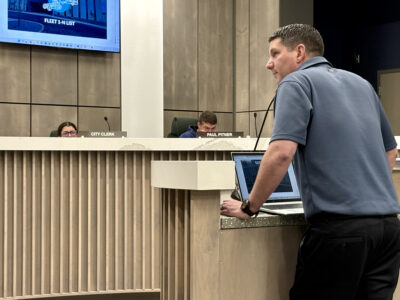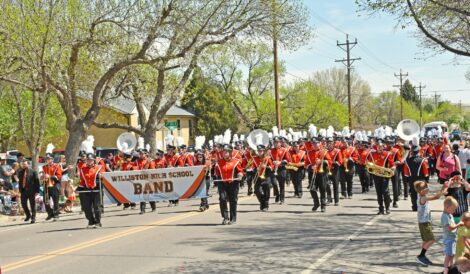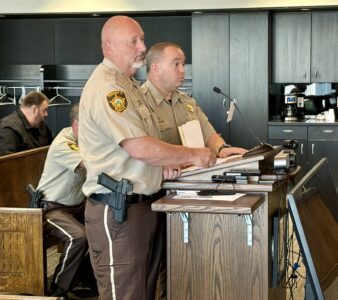ND remains national leader in UAS industry

Submitted Photo Taking part with the UAS Council in this fall’s Autonomous Nation Conference in West Fargo are, from left, Lacee Bjork-Anderson, vice president of Government Relations; Stacey Mesteth, vice president of Operations; Matt Dunlevy, CEO; Professor Seth Simonson, secretary of the Board of Directors and UAS educator at North Dakota State College of Science; Terri Zimmerman, Board of Directors and CEO for UAS companies; Zach Peterson, vice chair of the Board of Directors and director of Business Development at Vigilant Aerospace Systems.
GRAND FORKS – North Dakota is poised to remain a major player in the nation’s unmanned aircraft and autonomous systems industry, according to Matt Dunlevy, president/CEO for the North Dakota Unmanned Autonomous Systems (UAS) Council, Grand Forks.
“It’s almost a good 20 years,” he said of the birth of the UAS industry in the state. “Industry has been, I’d say, truly crystallizing over the last five to seven years.”
Dunlevy initiated the formation of the nonprofit N.D. UAS Council two and half years ago after legislators suggested forming an organization to serve as a voice for the burgeoning industry.
“Our mission is to promote and advocate the UAS sector in North Dakota and to provide ongoing networking opportunities and general updates through our communicatory channels. What it boils down to is we seek to be a group of champions of UAS in the state of North Dakota,” Dunlevy said. “Our Congressional delegation and our senior political leadership have fostered an environment where it also makes sense to have industry champions for UAS.”
He noted the organization has representation from across the state. The council includes members associated with various types of artificial intelligence or autonomous capabilities. It is not just drones but all types of autonomous systems, he said.
For instance, one member is a company that makes an autonomous compact vehicle used in the agricultural industry to haul products. Another member is a Fargo battery manufacturer whose product is making the U.S. competitive in that sector of the UAS industry, Dunlevy said.
Many members are in the unmanned aviation systems sector. North Dakota’s Grand Sky in Grand Forks and Vantis are members. Grand Sky is a partnership among the United States Air Force, Grand Forks County and Grand Sky Development with the nation’s first commercial UAS business and aviation park. Vantis is a statewide network enabling UAS flights beyond line of sight.
The council’s membership includes the Delta Advisory Group, which is heavily versed on the Department of Defense and does consulting in North Dakota, Dunlevy said. Many of the state institutions of higher education also have joined. Williston State College was a founding member.
The council has been speaking out on policy issues affecting the industry, including taking a position against the property tax elimination measure that failed on November’s ballot, saying the proposal would put the future of innovation and economic development at risk.
Dunlevy said the council will be active during the upcoming legislative session on issues affecting the industry. One of the council’s goals will be to encourage state government to maintain and grow its uses of UAS.
Dunlevy said the state Bureau of Criminal Investigation and many sheriff departments have been progressive in their adoption of UAS in law enforcement and first response. He noted the state Department of Transportation also has been a significant adopter of UAS technology, and the state Agriculture Department has created a UAS program for Palmer amaranth detection and eradication.
The 2023 Legislature directed its legislative management to study autonomous system capabilities and infrastructure to provide solutions for infrastructure inspection, rural emergency service needs, agriculture advancement, energy industry application and other uses. Recommendations and legislation are to be reported to the 2025 Legislature.
When it comes to UAS nationally, Dunlevy said North Dakota is in the catbird seat.
“On a per capita basis, our number of subject matter experts is probably higher than elsewhere in the country,” Dunlevy said. Based on the experiences available and tribal knowledge formed, he said, “We’re punching way above our weight.”
“I believe that the North Dakota UAS Council, building its palpable momentum as admirably as it is, is another symbol of the state of North Dakota’s premier leadership in the United States when it comes to the UAS sector, both public and private,” he said.
Dunlevy said there’s plenty of opportunity for North Dakota to continue to expand its UAS industry, too. One area the state’s industry is positioned to grow is national defense. A recent study ranked North Dakota 49th among the 50 states in the number of defense contracts acquired within the state, Dunlevy said.
He cites the work being done, both in the commercial and defense sectors by the council’s national partner, Association for Uncrewed Vehicle Systems International (AUVSI). AUVSI was founded more than 50 years ago by a group of U.S. Air Force officers and contractors.
“With the continued collaboration between our entities and those national entities, I think you’ll see North Dakota come up in that ranking because of how strong our industry is, together, right now,” Dunlevy said. “There are opportunities in terms of contracts, opportunities in terms of new research and new technologies, and then opportunities in terms of new sectors that pertain to UAS and autonomous systems, like counter UAS. So, you see this new, refreshed spirit of collaboration throughout North Dakota with the entities, and ultimately that is going to spell more opportunities.”
He said one message of the N.D. UAS Council and groups such as AUVSI is that industry coalitions can be key to stimulating new technologies that make America competitive in the market. China is the elephant in the room in discussing UAS competition, but the United States still leads the world in certain technologies, including artificial intelligence, he said.
“But, similar to how there’s always going to be more opportunities for UAS, there needs to be more education opportunities in North Dakota,” he added. “As we have the technological infrastructure in North Dakota, we really need to continue the intellectual infrastructure.”
North Dakota’s state colleges are talking up drones and building a passion in students, but the addition of more two-year and certificate programs could help launch students toward four-year or master’s degree programs, he said.
The N.D. UAS Council plans to introduce a scholarship for students interested in a UAS field.
Dunlevy, who has been a leader in UAS technology in the state, had opened an office for his company, SkySkopes, in Minot in 2016. SkySkopes has shifted focus to the southern U.S., but Dunlevy has kept his eye on North Dakota’s industry through the UAS Council.
“There are companies that are all over the state that the council helped to relocate to North Dakota to do business,” he said. “I really think that economic development piece, and keeping this momentum that we have going as an organized group, is going to keep us competitive.”





